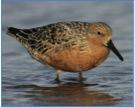To the dismay of Red Knot watchers – from biologists to birders and students – the rufa subspecies of Red Knot has seen its population decline by 75% since the 1980s, but now there is a new hope for the species.
The rufa Red Knot was added to the ESA candidate list in 2006, but its listing as threatened has been delayed. “Threatened” status means that the species is likely to become an endangered species within the foreseeable future. An endangered species is at risk of going extinct. A threatened listing for the Red Knot will result in federal funding for scientific research, the implementation of conservation practices throughout its U.S. range, and the identification of critical habitat—areas essential to the conservation and management of the Red Knot.
The rufa subspecies of Red Knot, along with polar bears and wolverines, are also one of the first animals to be categorized as threatened as a direct result of climate change. Sea level rise associated with climate change is a threat to Red Knot migrating and wintering habitats, while climate change can also alter the timing of food availability throughout the year or increase predation on the knots’ Arctic breeding grounds. For example, changes to the timing of insect hatches in the Arctic could leave Red Knots and their chicks without the food source they rely on during the nesting season.
In addition to benefits to the rufa Red Knots themselves, there is also an economic incentive behind protecting shorebirds. Cities that the birds visit have noted sizeable increases in business due to eco-tourists and bird watchers. According to a recent study, “South Jersey found that the shorebird-watching industry generated nearly $36 million dollars in revenue for the area.”
Why is the Red Knot rufa Population Declining?
The rufa subspecies—one of six distinct populations of Red Knot—undertakes an incredible journey twice a year, from the Canadian Arctic 9,300 miles south to Argentina’s Tierra del Fuego, and that journey is under threat on several fronts. The Red Knot’s migration is among the longest annual migration of any bird species, and it takes impeccable timing and just the right resources for the knots to survive it.
Migration is fueled by fat the knots build up by gorging themselves on invertebrate prey they pick out of the sand and mud. They nearly double their body weight in the process, storing up enough energy to fly up to 5,000 miles without stopping. When they run low on energy, they need to find safe stopovers sites where they can to rest and refuel. Many of these stopover sites are on the Atlantic coast of the U.S. One of the most critical stopover sites, Delaware Bay, is also one of the most important factors in their declines.
Each May most of the rufa Red Knots can be found in the bay, in search of horseshoe crab eggs. Their migration is timed to coincide with the crab’s annual spring spawning, but commercial overharvest of the eggs has depleted the Red Knot’s food supply. When knots don’t put on enough weight at their stopovers, they may arrive at their Arctic breeding grounds too weak to nest successfully, or they never arrive at all. In addition to Delaware Bay, the USFWS identifies habitat degradation and loss across the knot’s range from a variety of sources including coastal engineering projects and chronic disturbance—as reasons for the knot’s decline.
The USFWS plans to make a final decision on the rufa Red Knot’s status 2014.
What You Can Do
Red Knots have been nominated for increased protection, but they need you to lend your voice to ensure their safety. The proposal to list Red Knots status as threatened is open for public comment until November 29, 2013. You can add your comment by visiting the Audubon Action Alert Center—and don’t forget to personalize your message with why you support Red Knot conservation!
Read more here.




